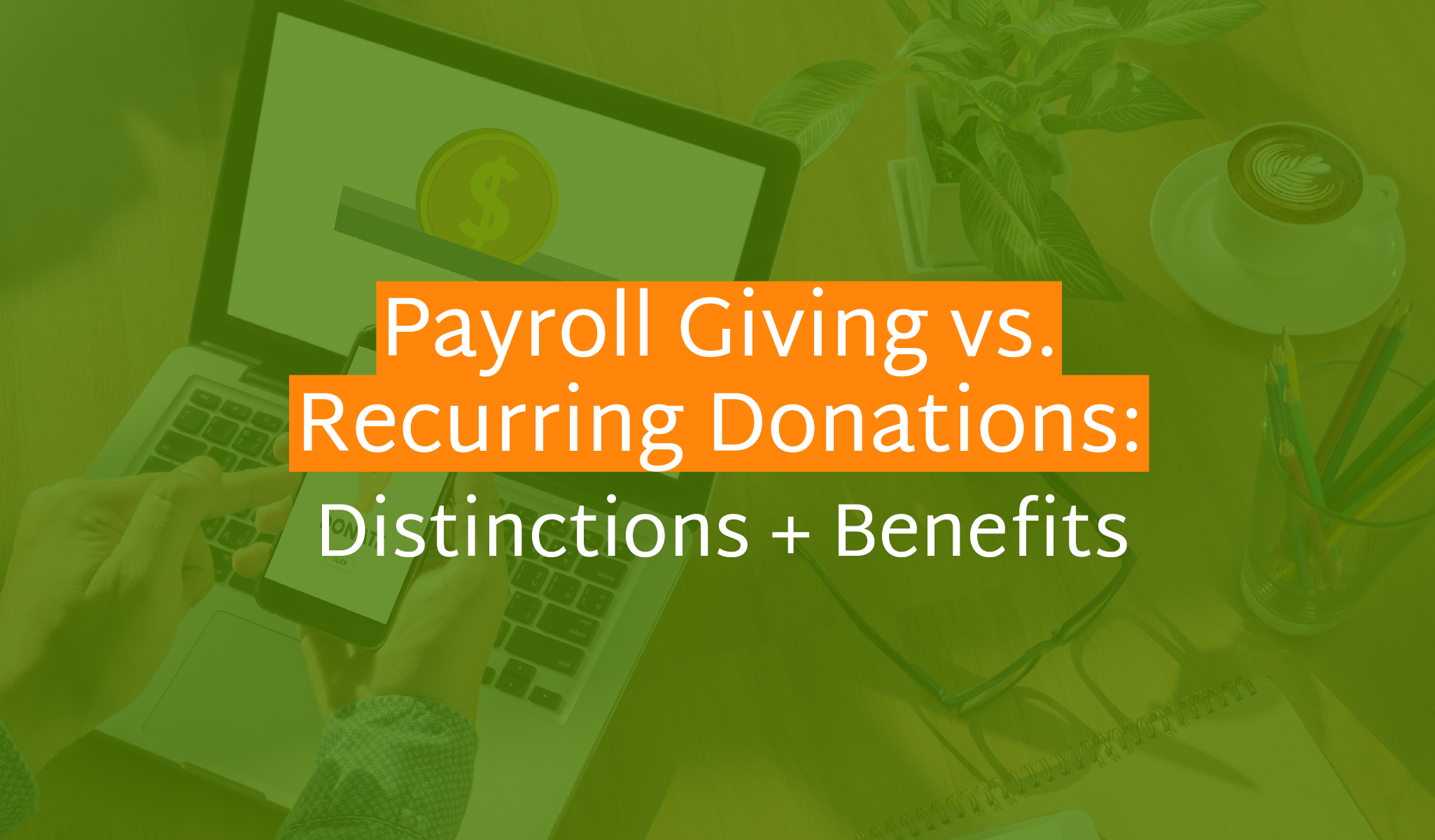
In the ever-evolving landscape of nonprofit fundraising, organizations are continually seeking effective strategies to maximize revenue and build sustainable donor support. Among the many giving options available, payroll giving and recurring donations stand out as two of the most reliable and scalable methods. Each offers unique benefits for both donors and nonprofits, but they also present challenges that organizations must navigate strategically.
In this guide, we’ll unpack the differences between payroll giving and recurring donations, explore their advantages and limitations, and provide insights into how nonprofits can decide which method best aligns with their fundraising goals.
- Understanding Payroll Giving
- Benefits of Payroll Giving
- Understanding Recurring Donations
- Benefits of Recurring Donations
- Comparing Payroll Giving and Recurring Donations
Ready to make the most of both payroll and recurring giving for your organization? Let’s get started.
Understanding Payroll Giving
Payroll giving is a structured system that allows employees to donate directly to a nonprofit from their paycheck before taxes are applied. Unlike one-time donations or even typical recurring gifts, payroll donations are facilitated through the employer’s payroll system, making them easy, consistent, and often tax-advantaged.
How Payroll Donations Work
When an employee opts into payroll giving, they select a nonprofit or multiple nonprofits to support and designate a specific contribution amount. The employer then deducts that amount automatically from each paycheck and forwards it to the nonprofit(s).
Some employers enhance these programs by offering matching gifts, doubling or even tripling the impact of their employees’ donations. Others integrate payroll giving with broader corporate social responsibility (CSR) initiatives, weaving philanthropy into their company culture.
Current Trends + Challenges in Payroll Giving
While payroll giving provides clear advantages, recent data shows challenges in adoption. Participation rates have declined by 13% in the last few years, with only about 516,000 employees actively participating in payroll giving programs. Even more striking, 59% of employees are unaware that payroll giving even exists. (Source: Double the Donation’s Payroll Giving Statistics)
This lack of awareness represents a major gap for nonprofits, but also an opportunity: with the right education and outreach, nonprofits could tap into a substantial source of untapped contributions.
Benefits of Payroll Giving
Payroll giving offers several advantages for both employees and nonprofits. Understanding these benefits can help organizations promote this giving method more effectively.
Tax Efficiency
One of the primary benefits of payroll giving is the tax efficiency it offers employees. Donations are made before taxes are deducted, which can lower the employee’s taxable income. This feature makes payroll giving an attractive option for many individuals looking to maximize their charitable contributions.
Convenience
Payroll giving is incredibly convenient for employees. Since donations are automatically deducted from their paychecks, employees do not have to remember to make contributions each month. This ease of use can lead to higher participation rates when employees are aware of the program.
Company Involvement
Payroll giving often aligns with a company’s corporate social responsibility (or CSR) goals. Employers that promote payroll giving foster a culture of philanthropy, boost employee morale, and create shared pride around charitable involvement. This can deepen nonprofit-employer relationships and open doors to additional support, such as sponsorships or volunteer opportunities.
Understanding Recurring Donations
On the other hand, recurring donations involve donors committing to give a set amount (usually monthly) through a nonprofit’s website or fundraising platform. Unlike payroll giving, which is tied to employment, recurring donations are donor-driven and typically managed through a credit card, bank transfer, or digital wallet.
How Recurring Donations Work
A donor selects their preferred giving frequency (monthly, quarterly, or annually), chooses the amount, and sets up an automated schedule. These gifts continue until the donor cancels or updates their preferences.
Current Trends + Challenges in Recurring Donations
Recurring donations have seen significant growth in recent years. The percentage of donors giving monthly has nearly doubled from 3.76% in 2019 to 6.23% in 2024. This rise reflects a broader cultural shift: donors increasingly want to build ongoing relationships with causes they care about rather than making occasional, one-off contributions. (Source: Zeffy’s Recurring Donor Benchmarks)
Despite their advantages, however, recurring donations also come with challenges that nonprofits must address. For one thing, there’s the potential for donor fatigue. If donors feel overwhelmed by frequent requests for contributions or updates, they may choose to disengage. Nonprofits must strike a balance between keeping donors informed and not overwhelming them with communication. At the same time, recurring donations can also face cancellation rates, as donors may change their financial situations or priorities. Nonprofits need to implement strategies to retain these donors, such as personalized communication and recognition of their contributions.
Benefits of Recurring Donations
Recurring donations offer numerous advantages for nonprofits, making them an appealing option for organizations seeking to enhance their fundraising efforts.
Financial Stability
Recurring gifts provide nonprofits with reliable, predictable income. On average, recurring donors give $24 per month ($288 annually), providing a steady foundation for budgeting and program planning. (Source)
Enhanced Donor Retention
Recurring donors are more loyal: the average recurring donor supports an organization for 8.08 years, compared to just 1.68 years for non-recurring donors. This extended donor lifespan means nonprofits spend less on acquisition and benefit from significantly higher donor lifetime value. (Source)
Stronger Mission Connection
Donors who commit to recurring giving often feel more emotionally invested in a nonprofit’s mission. They may be more likely to engage with newsletters, volunteer opportunities, and advocacy efforts, further strengthening their relationship with the organization.
Comparing Payroll Giving and Recurring Donations
Both payroll giving and recurring donations offer sustainable, donor-friendly pathways for nonprofits. However, understanding the nuances between the two can help organizations determine where to focus their efforts. Each approach differs in terms of accessibility, financial outcomes, donor engagement, and long-term potential. By examining these areas side by side, nonprofits can identify where to invest their outreach energy and how to design complementary strategies that maximize revenue.
Awareness and Accessibility
Payroll giving programs often suffer from low visibility. Many employees are simply unaware that their company offers such an option, and even when they are aware, they may not fully understand how it works or what benefits it provides. Because employers typically control how payroll giving is communicated, nonprofits have limited direct influence in spreading awareness. This creates a situation where potential donors who might eagerly participate never even learn about the opportunity. To overcome this, nonprofits can focus on educating their supporters during donor outreach, incorporating payroll giving prompts into donation forms, and equipping donors with resources to inquire about their workplace programs.
Recurring donations, by contrast, give nonprofits much greater control. Organizations can promote recurring giving directly on their websites, through digital campaigns, and in donor communications such as newsletters or annual appeals. The simplicity of the setup (usually just a box to check or a button to click during the donation process) makes recurring donations highly accessible. Because nonprofits manage the messaging themselves, they can craft targeted appeals that emphasize ease, affordability, and impact, tailoring communication to resonate with different donor segments. The autonomy nonprofits have in promoting recurring giving makes it a more flexible and scalable option, especially for organizations without strong corporate partnerships.
Financial Impact
Recurring giving provides nonprofits with a steady, predictable income stream. Monthly donors contribute smaller amounts at a time, but the cumulative effect is powerful. For example, a donor contributing $25 per month provides $300 annually, often without feeling a major financial burden. This consistency enables nonprofits to plan budgets more effectively, reduce reliance on one-time fundraising campaigns, and allocate resources toward mission-driven work rather than constant donor acquisition. The financial predictability of recurring giving also provides reassurance during times of economic uncertainty, when large one-off donations may decline.
Payroll giving, while often less visible, has the potential to generate higher overall contributions when leveraged effectively. Because payroll deductions are pooled across employees within a company, the combined impact can be significant. A mid-sized company with 100 employees each donating $20 per month could generate $24,000 annually for nonprofits, and that figure doesn’t include employer matching contributions, which can double or triple the total. The scalability of payroll giving lies in its collective nature: small, consistent gifts multiplied across a workforce add up quickly. While nonprofits may not have direct access to every employee, cultivating strong relationships with employers can unlock large-scale financial opportunities.
Donor Engagement
Recurring donations foster deeper emotional connections between donors and nonprofits. Because recurring donors typically sign up directly on a nonprofit’s platform, they engage with the organization’s story, mission, and impact from the outset. These donors are also more likely to interact with ongoing communications, attend events, and volunteer, further strengthening their connection. This engagement builds loyalty, and as a result, recurring donors often remain with nonprofits far longer than one-time givers. The personal, mission-driven nature of recurring giving makes it a strong foundation for donor cultivation and stewardship.
Payroll donors, on the other hand, may not have the same immediate sense of connection. Many view their contributions as part of a workplace initiative rather than a personal relationship with a nonprofit. This can create challenges for retention and engagement, as the nonprofit’s mission may not be top of mind. However, this does not mean payroll donors are less valuable. With intentional storytelling and personalized stewardship, nonprofits can transform these donors into long-term supporters. For example, sending impact reports, thank-you messages, and stories about how payroll contributions have made a difference can help donors feel connected beyond their workplace environment. By bridging the gap between transactional payroll deductions and personal engagement, nonprofits can strengthen loyalty and encourage further giving.
Long-Term Sustainability
Recurring donations provide nonprofits with independence because they are not tied to employment status or corporate policies. Even if a donor changes jobs, as long as they maintain their recurring contribution through their bank or credit card, the nonprofit continues to benefit. This makes recurring giving a more portable and flexible form of support. The stability and longevity of recurring donations make them particularly well-suited for long-term planning, program scaling, and building a reliable base of mission-driven supporters.
Payroll giving, while dependent on employer participation, has long-term sustainability advantages of its own. It strengthens ties between nonprofits and companies, opening doors to broader corporate philanthropy opportunities. Beyond payroll donations, companies may invite nonprofits to participate in volunteer events, apply for sponsorships, or benefit from employee volunteer grants. Payroll giving can serve as the entry point for building multifaceted corporate relationships that extend well beyond financial contributions. Nonprofits that nurture these partnerships may find that payroll giving becomes the foundation of a much larger corporate engagement strategy, ultimately diversifying and stabilizing their revenue over the long term.
Conclusion
In conclusion, both payroll giving and recurring donations offer unique advantages and challenges for nonprofits. While payroll giving provides tax efficiency and convenience, its declining participation and limited awareness may hinder its overall impact. On the other hand, recurring donations are experiencing significant growth, providing nonprofits with a more reliable and engaged donor base. Organizations should consider these factors when developing their fundraising strategies to ensure sustained support and financial health.
By understanding the nuances of both payroll giving and recurring donations, nonprofits can unlock their full potential for fundraising success. Start exploring these options today and enhance your organization’s impact!
Drive Payroll Giving with Double the Donation’s Tools
Ready to make payroll giving a cornerstone of your nonprofit’s fundraising strategy? Double the Donation’s tools help you identify eligible donors, connect them with their employers’ payroll giving programs, and maximize participation with ease. Our platform streamlines the process so supporters can give consistently while your organization benefits from predictable, recurring revenue.
Get a demo today and see how Double the Donation can help you double your payroll giving donations!
